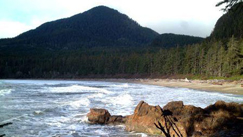Protecting the 'Galapagos of the North'

The federal government has announced plans to expand protection for an area off
British Columbia’s northern coast known among conservationists as
the “Galapagos of the North.”
The spectacular islands that make up Haida Gwaii have long been
protected within Gwaii Haanas national park but for years that
protection stopped at the beach.
Now the federal government says it will protect a 3,500-square
kilometre area covering the waters and seabed surrounding the
archipelago formerly known as the Queen Charlotte Islands.
Environment Minister Jim Prentice tabled an amendment Monday to
formally establish the area as Gwaii Haanas National Marine
Conservation Area Reserve and Haida Heritage Site.
Prentice said the amendment marks the first time a national
marine conservation area has been established under the Canadian
National Marine Conservation Areas Act, a move hailed by some
environmental groups as landmark progress.
“Today’s milestone is the result of an
historic and outstanding collaborative partnership between the
Government of Canada and the Haida Nation.” Environment Minister
Jim Prentice.
“As our maritime nation prepares to celebrate World Oceans Day
(Tuesday), I am sincerely proud of Canada’s international
leadership in protecting one of the most spectacular and wild
seascapes in our country.”
The heritage site will extend about 10 kilometres offshore from
the existing Gwaii Haanas park reserve, in an area that’s home to
blue whales, endangered Steller sea lions, songbirds and
corals.
The existing park and new conservation areas will protect more
than 5,000 square kilometres of wilderness in all, from mountain
tops to the deep sea. That’s a first not only for Canada, but also
the world.
“This is a changing of the tides,” said Guujaw, president of the
Haida Nation. Guujaw added it’s critical to “appreciate the fragile
and precious nature of our marine areas” and to “look after and
restore our oceans.”
The Canadian Parks and Wilderness Society also applauded the
move, which it said was reached after two decades of
discussion.
“The spectacular Gwaii Haanas islands were protected years ago.
But sadly, protecting its ocean took much longer,” said Sabine
Jessen, the organization’s oceans program manager.
“CPAWS has long advocated for the conservation of the waters of
Gwaii Haanas because they are so rich ecologically.”
Jessen congratulated the Haida for their vision to conserve the
waters and for persevering in the long years of discussions and
study by the federal government. She added all parties must give
their consent if the order-in-council is to be finalized before the
parliamentary session adjourns for the summer.
The region is famous for the culture of the Haida, whose black
and red art and traditional drumming and dance have become
synonymous with West Coast First Nations culture.
Haida Gwaii, which means Islands of the People in the local
language, was also an inspiration for artist Emily Carr, whose
renderings on canvas of Haida totem poles have etched them into
history.
Darcy Dobell, vice-president of Pacific conservation with World
Wildlife Federation Canada, also applauded the announcement.
“We’re definitely excited about the designation,” she said.
“It’s definitely a landmark for oceans management.”
Source: www.ctvbc.ctv.ca

